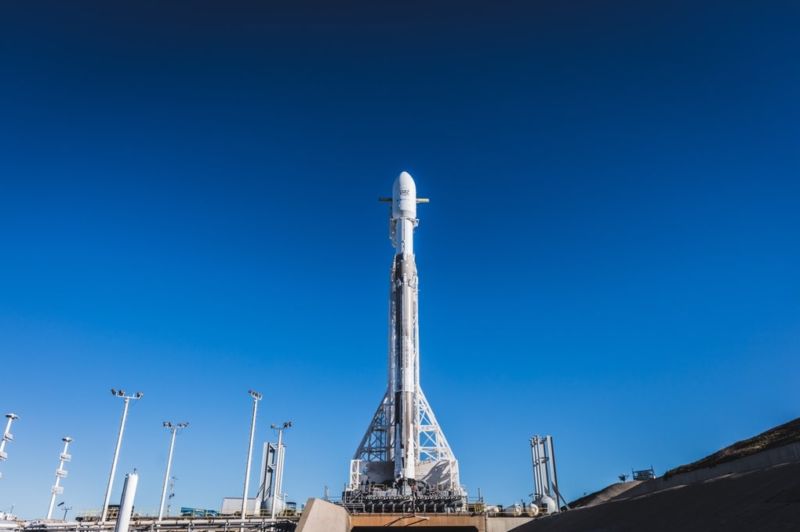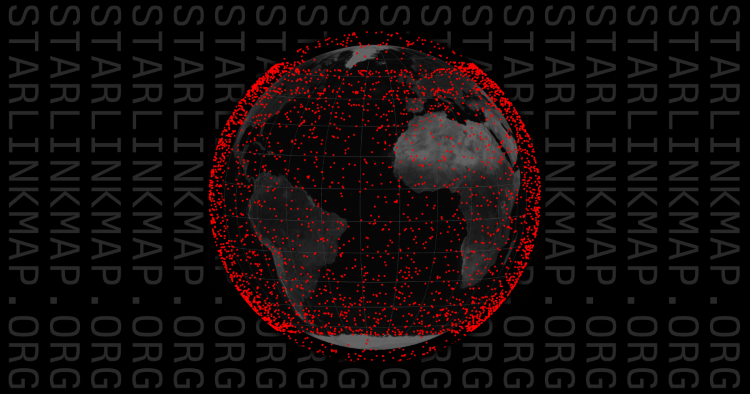Mention the name Starlink among the astronomy community and you will often be greeted with a shudder. There are now thousands of Starlink satellites orbiting Earth providing internet connectivity to every corner of the Earth. Many believe they are making astronomy difficult but now, SpaceX is launching another service; ‘direct-to-cell’ technology that will allow mobile phones to use satellites to send text messages as early as this year. Voice and data services are likely to follow on quickly next year. With smaller antennae at a lower altitude what is their impact on astronomy?
Continue reading “Starlink Direct-to-Cell Satellites are Coming. What Will Be Their Impact on Astronomy?”Watch a Real-Time Map of Starlinks Orbiting Earth
In an effort to enhance the educational outreach of their Starlink constellation, there is an interactive global map of their Starlink internet satellites, which provides live coverage of every satellite in orbit around the Earth. This interactive map and information was produced by Will DePue, who is a an OpenAI programmer and openly states he is not affiliated with SpaceX or Starlink. This interactive map comes as SpaceX continues to launch Starlink satellites into orbit on a near-weekly basis with the goal of providing customers around the world with high-speed internet while specifically targeting rural regions of the globe. In 2022, Starlink officially reached all seven continents after Starlink service became available in Antarctica. Additionally, SpaceX announced in 2023 a partnership with T-Mobile for Starlink to provide mobile coverage, as well.
Continue reading “Watch a Real-Time Map of Starlinks Orbiting Earth”Scientists in Antarctica Have Access to Starlink Now. It’s Available on 7 Continents
SpaceX’s Starlink service is now available in Antarctica, according to a tweet from the National Science Foundation on the morning of September 14, stating, “NSF-supported USAP scientists in #Antarctica are over the moon! Starlink is testing polar service with a newly deployed user terminal at McMurdo Station. Increasing bandwidth and connectivity for service support.” SpaceX replied with a quote tweet saying, “Starlink is now available on all seven continents! In such a remote location like Antarctica, this capability is enabled by Starlink’s space laser network.”
Continue reading “Scientists in Antarctica Have Access to Starlink Now. It’s Available on 7 Continents”SpaceX Launches the First of Thousands of Space Internet Satellites, but Didn’t Quite Catch the Fairing

After multiple delays, SpaceX’s PAZ mission launched from from Space Launch Complex 4 East (SLC-4E) at Vandenburg Air Force Base on the morning of Thursday, February 22nd. Shortly after it reached orbit, the rocket deployed its payload (the PAZ Earth Observing satellite) as well as and two Starlink demonstrations satellites that will test SpaceX’s ability to provide broadband internet service from orbit.
In addition, this launch was the first time that SpaceX would be attempting to “catch” the payload fairings from a Falcon 9 rocket using a retrieval ship. As part of their plan to make their rockets fully reusable, the rocket’s fairings were equipped with deployable chutes that would control their descent to the Pacific Ocean. Once there, the newly-commissioned “Mr. Steven” retrieval ship would be waiting to catch them in its net.
As noted, the primary mission for this launch was the deployment of the the PAZ satellite to low-Earth orbit. This synthetic-aperture radar satellite was commisioned by Hisdesat, a Spanish commercial satellite company, for governmental and commercial use. Its purpose s to generate high-resolution images of the Earth’s surface, regardless of whether there are clouds covering the ground.
https://www.instagram.com/p/BfgHKDNAplx/
The secondary payload consisted of two experimental satellites – Microsat-2a and 2b – which are the first phase in SpaceX’s plan to deliver broadband internet service to the entire world. The plan calls for the deployment of more satellites in phases, reaching a total of 4,000 by 2024. However, it was the attempted retrieval of the rocket’s payload fairings that was of particular interest during the launch.
To be fair, this would not be the first time that SpaceX’s attempted to retrieve payload fairings. In March of 2017, SpaceX successfully recovered the fairings for one of their Falcon 9s, which allowed them to recoup an estimated $6 million dollars from that launch. At present, SpaceX indicates that the cost of an individual Falcon 9 launch is estimated to be around $62 million.
If the payload fairings could be recovered regularly, that means that the company could stand to recoup an additional 10% from every individual Falcon 9 launch. These additional savings would not only make the company more competitive, but could allow for additional mission profiles that are currently considered too expensive.
Missed by a few hundred meters, but fairing landed intact in water. Should be able catch it with slightly bigger chutes to slow down descent.
— Elon Musk (@elonmusk) February 22, 2018
On Thursday Morning, SpaceX founder Elon Musk posted a picture of Mr. Steven taking to sea on Instagram with the following statement:
“Going to try to catch the giant fairing (nosecone) of Falcon 9 as it falls back from space at about eight times the speed of sound. It has onboard thrusters and a guidance system to bring it through the atmosphere intact, then releases a parafoil and our ship with basically a giant catcher’s mitt welded on tries to catch it.”
The launch, which was covered via webcast, went as planned. After taking off amid clear skies, the Falcon 9 reached orbit and deployed the PAZ satellite without incident, and the two Starlink satellites were deployed shortly thereafter. However, the webcast ended without providing any information about the status of the retrieval of the payload fairings.
At 7:14 am, Musk tweeted an update about the attempted retrieval, indicating that the fairings had landed in the ocean a few hundred meters from where Mr. Steven was waiting to catch them. While unsuccessful, Musk was optimistic about future attempts to retrieve payload fairings, saying:
“Missed by a few hundred meters, but fairing landed intact in water. Should be able catch it with slightly bigger chutes to slow down descent.”
As always, Musks seems undeterred by a setback and the company is moving ahead with its plans for expanded reusability. If successful, future attempts at retrieval are likely to involve the second stages of the Falcon 9 and Falcon Heavy rockets. Given all the possibilities that this will allow for, there are many who want to see Musk’s latest venture to succeed.
In the meantime, check out this webcast of the launch:
Further Reading: ArsTechnica
This is the Year Internet From Space Gets Really Serious

Between 2005 and 2017, the number of people who are digitally connected increased by a factor of three and a half. In other words, the number of people with internet access went from just over 1 billion to about 3.5, from about 15% to roughly half the world’s population. And in the coming decade, it is estimated that roughly 5 billion people – that’s 70% of the world’s population – will have internet access.
Much is this growth is powered by new ways of in which internet services are being provided, which in the coming years will include space-based internet. In 2018 alone, eight new constellations of internet satellites will begin deployment to Low-Earth Orbit (LEO) and Medium-Earth Orbit (MEO). Once operational, these constellations are expected to not only increas broadband access, but also demonstrate the soundness of the business model.
For instance, SpaceX will be launching a prototype internet satellite this year, the first of a planned constellation of 4,425 satellites that will make up its Starlink Service. As part of Elon Musk’s vision to bring internet access to the entire globe (one of many he’s had in recent years!), this constellation will be deployed to altitudes of 1,110 to 1,325 km (685-823 mi) – i.e. within LEO – by 2024.
Telecom and aerospace giants Samsung and Boeing are also sending internet satellites to orbit this year. In Samsung’s case, the plan is to begin deploying the first of 4,600 satellites to LEO by 2028. Once operational, this interconnected constellation will provide a 200-GB per month service in the V band for up to 5 billion users. Boeing has similar plans for a 2,956 constellation that will provide enhanced broadband (also in the V band).
The first part of this system will consist of 1,396 satellites deployed to an altitude of 1,200 km (746 mi) within the first six years. Others companies that are getting in on the ground floor of the space-based internet trend include OneWeb, Telesat LEO, SES O3B, Iridium Next and LeoSat. Each of them have plans to send between a few dozen and a few hundred satellites to LEO to enhance global bandwidth, starting this year.
Iridium, LeoSat, and SES O3B have all entered into partnerships with Thales Alenia Space, a leading designer of telecommunication and navigation satellites as well as orbital infrastructure. Thales’ resume also includes providing parts and services for the International Space Station, as well as playing major role in the development of the ATV cargo vessel, as part of the NASA/ESA Cygnus program.
In conjunction with Thales and Boeing, SES 03b plans to use its proposed constellation of 27 satellites to bridge the global digital divide. In the past, O3b was in the practice of providing cruise ships with wireless access. After merging with SES in 2016, they expanded their vision to include geosynchronous-Earth-oribit and MEO satellites. The company plans to have all its satellites operational by 2021.
Iridium is also partnering with Orbital ATK, the commercial aerospace company, to make their constellation happen. And whereas other companies are focused on providing enhanced bandwidth and access, Iridium’s main goal is to provide safety services for cockpit Wi-Fi. These services will be restricted to non-passenger flights for the time being, and will operate in the L and Ka bands.
And the there’s LeoSat’s plan to send up to 108 satellites to LEO which will be interconnected through laser links to provide what they describe as “an optical backbone in space about 1.5 times faster than terrestrial fiber backbones”. The first of these small, high-throughput satellites – which will deliver services in the Ka-band – is scheduled to launch in 2019.
Similarly, Telesat LEO hopes to create an internet satellite network to provide services that are comparable to fiber-optic internet connections. According to the company, their services will target “busy airports; military operations on land, sea and air; major shipping ports; large, remote communities; and other areas of concentrated demand.” The company plans to deploy two prototype satellites to LEO later this year, which were developed in conjunction with Airbus’ SSTL and Space Systems Loral.
With all the developments taking place these days, it does seem like the dream of a global internet (much like the Internet of Things (IoT) is fast becoming a reality. In the coming decades, we may look back at the late 20th and early 21st centuries the same way we look at the stone ages. Compared to a world where almost everyone has internet access and can download, upload, stream and surf, a world where only a few million people could do that will seem quite primitive!
Featured: Aviation Week, Popular Mechanics



